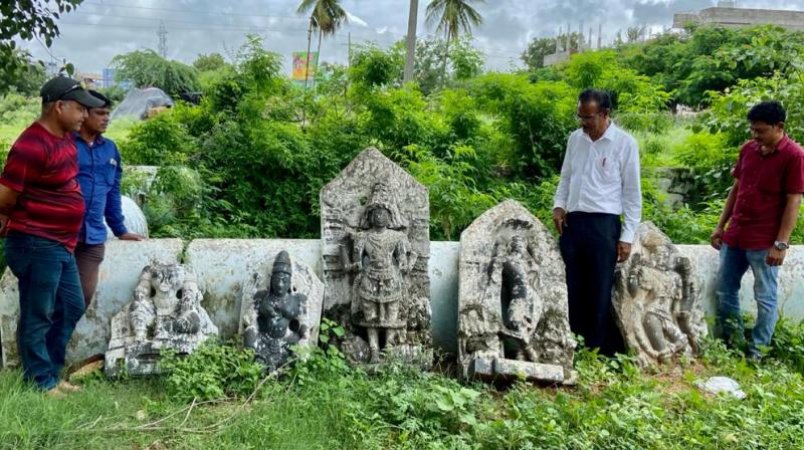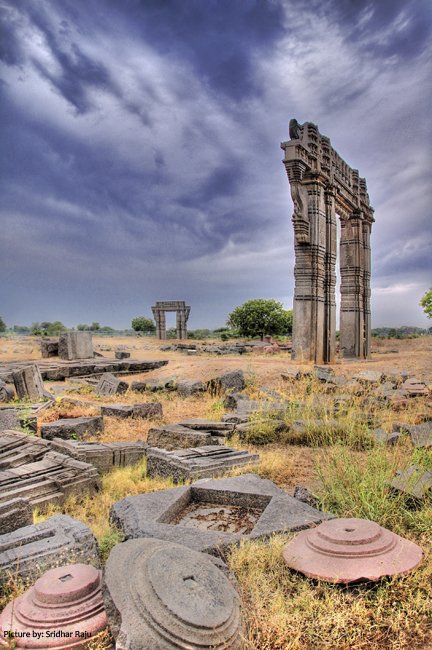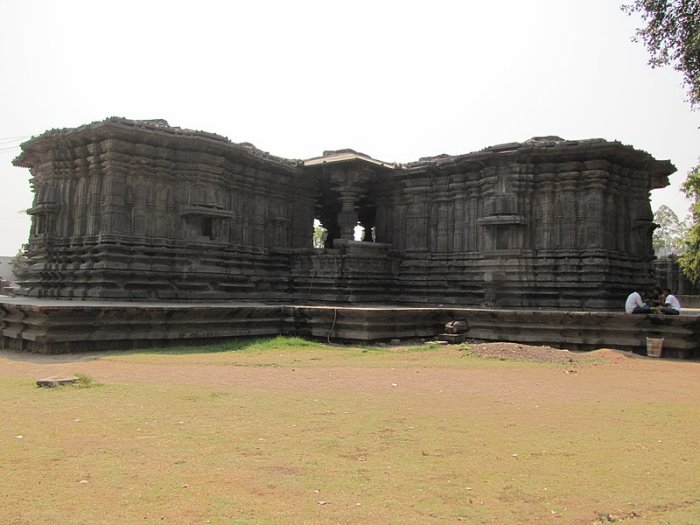Jan Bartek – AncientPages.com – Scientists in India have discovered rare and beautiful sculptures of the Kakatiya Dynasty near a temple. The 800-year-old sculptures are of great historical significance and exhibit the talent of the Kakatiya sculptors.

The finding was made by representatives of New Telangana History Group (NTHG) headed by Sriramoju Haragopal who found the five 13th-century sculptures in a neglected condition near a temple tank at Duddeda village in Siddipet in the state of Telangana, India. Credit: The Hindu
Five Magnificent Sculpures Made By The Kakatiyas
“After finding five sculptures of the Kakatiya era, the members of NTHG Ahobilam Karunakar, Samaleti Mahesh, and Md. Naseeruddin pᴀssed the information to Dr. E. Siva Nagireddy, archaeologist and chief executive officer of The Cultural Centre,” the Deccan Chronicle reports.
After examining the sculptures, scientists could determine two are Devi sculptures, and three sculptures are of Chennakesava, Venugopala, and Bhairava.
According to Dr. Nagireddy, who visited Duddeda village and inspected the sculptures, they are a masterpiece of Kakatiya art. The statues’ ornamentation and iconography represent fine workmanship belonging to the flourishing phase of the Kakatiya art in the 13th and 14th century.
History And Legacy Of The Kakatiya Dynasty
The Kakatiya Dynasty lasted from about 1163 to 1323. The southern Indian dynasty ruled most of the eastern Deccan region at its height, comprising present-day Telangana and Andhra Pradesh, and parts of eastern Karnataka and southern Odisha. The capital of the Kakatiya Dynasty was in Orugallu, now known as Warangal, the second-largest city in Telangana.
The Kakatiya rulers traced their ancestry to Durjaya, a legendary chieftain of the Andhra kingdom.

Ruins of the Kakatiya Kala Thoranam (Warangal Gate). Credit: B.Sridhar Raju – CC BY-SA 3.0
“The Kakatiyas, also originally feudatories of the later Chalukyas of Karnataka, made the comparatively barren tract of Warangal to the northeast of Hyderabad the base of their independent power from about the beginning of the 12th century.
Under some able rulers the Kakatiyas became a major power in Andhra from the 12th to the early 14th century, not only through a sustained policy of agrarian expansion and support provided to overseas trade, but also through repeated administrative reorganisations.
In addition to these major powers, there were a number of other ruling families in different localities who either aligned themselves with the major powers or, like the Pandyas of southern Tamil Nadu and the Kulasekharas of Kerala, fought them to retain their autonomy.” 1
In the ancient capital of the Kakatiyas, there are still magnificent buildings that testify to the greatness of these skilled Hindu builders. One of the most impressive ancient structures, considered a great legacy of the Kakatiya Dynasty, is the marvelous Thousand Pillar Temple in Hanamkonda. The Kakatiyas also constructed the Ramappa Temple in Palampet, Warangal Fort, and Kota Gullu in Ghanpur.
Muslim Rulers’ Destruction Of Hindu Temples
The Kakatiya Dynasty engaged in many battles with the Muslims, but the enemy’s army was overwhelming. The Kakatiyas could not resist the Muslim invasion though they tried. Delhi Sultanate ruler Alauddin Khalji had his eyes on the kingdom and saw an excellent opportunity for plunder. The Warangal Fort “fell to Ulugh Khan, who later ruled Delhi as Mohammad Tughluq.
Prataparudra, the last Kakatiya ruler, killed himself on the road to captivity. After this the fort changed hands several times until it was absorbed into the Qutb Shahi Empire in the 15th century.

Thousand pillar temple in Warangal, India. Credit: Nikhil B – CC BY 3.0
Inside the fort are four mᴀssive toranas, the gateways of the Sahasralinga Temple, destroyed at the time of Ibrahim Qutb Shah. The scattered fragments are clearly from the high period of Kakatiya art, the reign of Ganapatideva, the same period as the temples at Palampet and Ghanapur.” 1
“The nature of medieval Hindu-Muslim relations is an issue of great relevance in contemporary India. Prior to the 200 years of colonial subjection to the British that ended in 1947, large portions of the Indian subcontinent were under Muslim political control. An upsurge of Hindu nationalism over the past decade has led to demands that the state rectifies past wrongs on behalf of India’s majority religion. In the nationalist view, Hindu beliefs were continually suppressed, and its insтιтutions repeatedly violated during the many centuries of Muslim rule from 1200C.E. onward.
See also: More Archaeology News
The focal point of nationalist sentiment is the most visible symbol of Hinduism, its temples. As many as 60,000 Hindu temples are said to have been torn down by Muslim rulers, and mosques built on 3,000 of those temples’ foundations. The most famous of these alleged former temple sites is at Ayodhya in North India. The movement to liberate this sacred spot, supposed defiled in the sixteenth century when the Babri Masjid mosque was erected on the ruins of a Rama temple, as one of the H๏τtest political issued of the late of the late 1980s and early 1990s.” 2
Destroyed Hindu sculptures like the one discovered at Duddeda village testify to religious violence. It is vital to preserving ancient Hindu history. This can be done by protecting the five Kakatiya sculptures by moving them inside the temple premises to ensure their safety and security. Dr. Nagireddy has appealed to the government in this case.
Written by Jan Bartek – AncientPages.com Staff Writer
Expand for references
- Insight Guides – Insight Guides South India
- Talbot, Cynthia. “Inscribing the Other, Inscribing the Self: Hindu-Muslim Idenтιтies in Pre-Colonial India.” Comparative Studies in Society and History37, no. 4 (1995): 692-722





